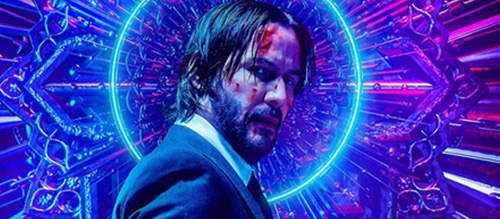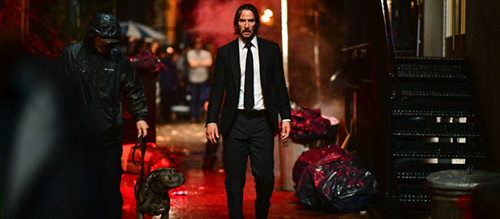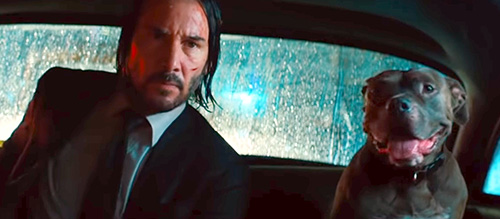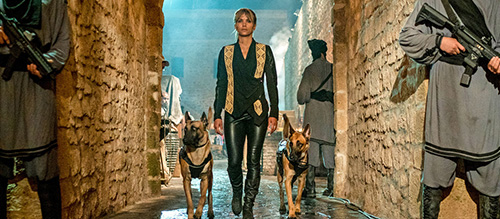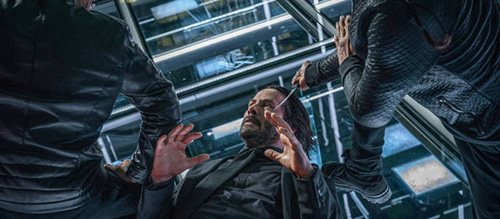A Textual Analysis of ‘John Wick Chapter 3 – Parabellum’
I haven’t seen the other John Wick films since their respective releases, so I went into John Wick Chapter 3 — Parabellum almost blind. Most of my memories from the previous films include the death of his dog, the massive amounts of kills, and the hotel where assassins gather, but it’s the “realistic” gun use that initially intrigued me – Keanu Reeves trained with expert Taran Butler to ensure proper grip, practical weapon changes and consistent reloading in combat (something your average action flick overlooks), and these skills continue to shine in the third instalment.
I was, however, caught off guard by just how good this movie actually is. Even beyond the violent realism.
Parabellum is an expressionist work, using colors in the lights and background objects to represent the flow of action and emotion. The film opens with John running through New York after killing the previous film’s antagonist inside of the Continental, the assassin hotel where killing is banned (he has become “excommunicado” from the assassin organization for breaking the rule). The edit is fast paced to match the clock ticking down to John’s excommunication, and he escapes to a library where he has stored items that will come in handy later.
During the opening sequence, John is bathed in blue light, and this blue light is consistently contrasted with red and yellow lights throughout the film. Within the film’s context, blue represents the ever-present “High Table”, an ill-defined organization of assassins comprised of bureaucratic hipsters, assassins, adjudicators, and higher bosses like Ian McShane’s Winston, Jerome Flynn’s Berrada and an Elder that may or may not be in charge of the whole thing. Members of the High Table are shown in blue outfits, or sport a blue article of clothing like the Elder’s light blue turban (others are shown in darker shades of blue, showing a distinction from the other members and the lighting’s shade).
As John escapes to the library, red is prominently contrasted with that blue light, bringing me to the conclusion that red represents John Wick, his interests and those willing to work with him – he is a human Angel of Death, bringing bloodshed everywhere he goes.
During fight scenes, John’s victory is foreshadowed through red objects in the background. In one sequence John fights in close combat using knives, and the background is lined with red cabinets. As he fights and kills, the action transitions away from red and John gets into trouble. This trouble ends when John and his opponents end up in front of a new set of red cabinets, a sign of the blood about to be spilled. Red fabrics placed in the background function in a similar way to the cabinets in other scenes. The red throughout the early film also shows John’s status as “excommunicado” from the Continental, based on contrast with green lighting later in the film when John and the Continental work together to fight against the table.
John spends a lot of time in red and dark blue lights at the start of the film, and as his clock ticks down, we see Winston in the Continental under yellow lights. This yellow light is caution, a warning of danger for John. The yellow in that initial scene is repeated in the library, where John fights a character played by NBA player Boban Marjanovic, a huge guy by basketball standards at 7’3” (2.2 meters); an expressionist symbol for John Wick as an underdog.
Another example of yellow representing danger for John occurs without him on the screen…
When the Adjudicator visits the assassin Zero, an admirer of John’s work, his restaurant is covered in red light. As the scene goes on, the Adjudicator recruits Zero to kill John, and the lighting shifts to yellow. Zero and his students are shown to be formidable opponents for John, more so than other assassins that come after him. Every instance of yellow lighting that doesn’t contain an ally of John’s (such as the Director who wears a red sweater) leads to a dangerous situation.
There are also mythical allusions that make this story so fascinating.
John is akin to Greek heroes; a killer of great renown. He is told to travel to the desert and follow Orion’s dog (the star Sirius, I think. The film doesn’t specify) and, when he reaches the point of death, the Elder will find him. John finds that following the dog reveals his way out; becoming a tool, a dog, tasked to do the High Table’s bidding. At the end John realizes he’s not Orion’s dog, he is Orion… a hunter. The encounter with the Elder is an allusion to Jesus’ desert wanderings, where he finds Satan at the end for a final test. The Elder offers John a chance at life in exchange for a sacrifice – the sacrifice is his wedding finger and henceforth his ring; his physical reminder of the memory of his wife. That memory is the entire reason he wants to live, and it’s akin to selling his soul to the Devil.
John Wick’s memory, his blood, anger and rule breaking, all point to a humanist take on myth. John is substitute for Greek demigod heroes, the High Table a human pantheon, and Laurence Fishburne’s Bowery King and his vagrant minions (the “bottom tier” of modern human society) serve as substitutes for Hell in this world of assassins. The Bowery King, who claims to be the source of the High Table’s power (kind of like the Greek Titans), is given seven cuts and sent “below the Table,” and we last meet him underground on a throne near raging fires that are both an allusion to Hell/Tartarus and an expressionist symbol of the rage he and John feel. From the beginning of the film, John fought long and hard to go from hunted to hunter, and at the end he is no better than where he started. He has pushed his rock like Sisyphus as punishment for his violation of rules and the Continental’s hospitality, and now he’s going to prepare for war.
These are some of the great things about Parabellum, but a closer reading of the picture leaves me with thoughts and questions about the film’s meaning.
My first specific question surrounds rules and fate’s ineligibility. We are told and shown throughout the film that breaking rules has consequences – this starts with the hunt for John when he is “excommunicado”. continues when he visits a doctor to stitch him up five minutes before the countdown ends, and then the Adjudicator mentions it over and over again (just in case we weren’t quite sure). On the one hand, death is the punishment for rule breaking (as we see through the bounty on John), but injury/maiming is also used as punishment, and so is “Deconsecration” of Table-sanctioned buildings like the Continental.
Despite all of this establishment, and inconsistent (but present) punishment, we also see characters evade consequences.
Sofia, another assassin who helps John (she has red pillows, displaying a “soft spot” for John), lives with no consequence. Winston’s show of strength against the Table is rewarded with reconsecration. These signs of mercy don’t even contrast with John, who also leaves assassins alive when he feels like it because of a sort of mutual respect.
The narrative’s discussion of rules and emphasis on consequences leaves an obvious question: is breaking rules okay, or not?
The High Table, the unquestionable antagonist and keeper of rules, fails in the end because John Wick lives. Fate and rules can clearly be violated through sheer force of will, but the film itself fails to embody this message within its form and visual language. John Wick Chapter 3 — Parabellum is a product of properly following cinematic rules, a testament to the virtue of conformity. The use of primary colors is very traditional, specifically the use of red and yellow – I was hoping the colors might grow more complex beyond green (a “green light” to kill in the Continental, and a combination of blue and yellow to demonstrate the fear of the Table’s agents that are about to meet their doom), maybe like the palette of the official poster which contains pink, purple, yellow and orange. These colors aren’t all primary colors, and they mix and blend across the poster, portraying a sense moral complexity.
Moral complexity is notably missing in the film; Winston isn’t morally complex as he’s obviously on John’s side even through apparent betrayals, John is a force of “good” to the extent that his individualism and humanity oppose the High Table’s collective nature, and even Zero is a duty-bound assassin that sticks to the film’s “honorable” code. There are obvious signals of “good” and “bad” even if they don’t dictate the role a character plays in relation to John Wick.
The writing and editing also play into film tropes, attempting to subvert them with failed moments of humor under the guise of contemporary self-awareness.
Though John frequently runs the risk of severe injury, this isn’t Fast and Furious. It’s not like John skydives in a tank or takes damage with absolutely zero consequence (he does have to get sewn up and needs a few moments to catch his breath), it’s a film that typically takes itself seriously and succeeds when it’s doing that. Humorous moments like Zero having a conversation with John before he dies seem to undermine the serious moments more than they relieve any tension.
Unique scenes that make us go, “Woah, I can’t believe he just did that,” better serve the role humor usually plays in an action film.
One example is Parabellum’s pool scene, watching John shoot and avoid shots underwater is freakin’ nuts. Another good one is escaping through an antique store and ending up on a horse; the situation is odd, but it’s serious and intense, and the tensions between those two things create its own kind of humor. One-liners, alternatively, only serve to signal a cinematic convention within the action genre.
I’m also not too fond of moments when the camera leaves John to show a group of assassins about to follow him. They happen way too often, the exact same way almost every time. A movie with this level of realism should have a multiplicity of organic ways to introduce “someone is following John Wick”. There are also the convenient moments where John has his weapon ready just in time, which is jarring when mixed in with the “chaos and randomness” of the rest of the choreography.
John Wick’s positioning as the protagonist leaves me wondering about the morality of mass killing. 167 people die in this film as a result of John and his allies. When does self-defense cross into the territory of mass murder? At what point do we as an audience ask why John should be allowed to live? When do we begin rooting for people like the Adjudicator or Zero to take him out because it’s an absurd idea to believe there is no moral grey area in everything John has done? Maybe we are supposed to believe it, but the film continues to implicitly endorse him by allowing him to triumph through survival. He’s clearly a threat to the stability of the High Table, and are we to believe the High Table is never noble in its pursuits? Is John even able to be on a moral high ground above them? The absence of a conversation about the entire moral landscape of this film is replaced with the question of “what’s right for John Wick?” Others be damned.
I’m fascinated to see where the franchise goes from here. The fourth chapter already has a release date of 21 May, 2021. I’m not sure how they can raise the stakes further without explicitly making John and the Elder supernatural entities. At this point, it’s less metaphorical and more the implicit reality, but this film is truly a work of cinema to behold. The sound design and performances, as well as the world the team built, are incredible.
Parabellum is a great start to the summer movie season, and I couldn’t be happier to see a franchise succeeding at the box office!

